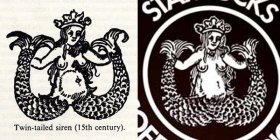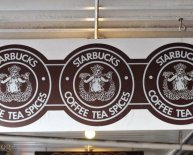
Where is the original Starbucks?
 By Carl Pyrdum
By Carl Pyrdum
There’s anything fishy in regards to the Starbucks logo design. Apart from the obvious, i am talking about. I know the grayscale woman within the green group is meant become a mermaid and, yes, mermaids are half-fish, half-woman, but We intended that there’s another thing fishy about this. Put differently, We smell a cover-up. Besides the apparent cover-up, i am talking about. I understand that the original logo design featured the mermaid’s bared breasts and, yes, they got covered up in later redesigns of the logo. But something else will be covered up. In other other terms, I smell a rat.*
Here is the formal history of the Starbucks logo, as available on Starbucks.com’s FAQ web page.***
When we were initially interested in a logo design for Starbucks in 1971, we desired to capture the seafaring tradition of very early coffee traders. […] We pored over old marine books until we developed a logo design based on an old sixteenth-century Norse woodcut: a two-tailed mermaid encircled because of the store’s original title, Starbucks Coffee, Tea, and Spice.
And this is actually the same story embellished slightly in business co-founder Howard Schultz’s 1997 guide Pour Your Heart engrossed: How Starbucks Build an organization One Cup at any given time where it goes something like this:
[Fellow Starbucks founder] Terry [Heckler] additionally poured over old marine publications until he developed a logo predicated on an old sixteenth-century Norse woodcut: a two-tailed mermaid, or siren, encircled by the store’s original title, Starbucks Coffee, Tea, and Spice. That early siren, bare-breasted and Rubenesque, was allowed to be since seductive as coffee it self.
Now, here’s the situation with this particular tidy little beginning tale: there’s no such thing as a 16th-century Norse woodcut. Don’t believe me? Decide to try here Google search:
 As you can see, it returns a paltry 40 outcomes, the majority of all of them just spam internet sites that clipped the expression from Starbucks’s web site or an article towards coffee organization, and people hits that aren’t junk e-mail are simply obliquely referring to Starbucks without using title.
As you can see, it returns a paltry 40 outcomes, the majority of all of them just spam internet sites that clipped the expression from Starbucks’s web site or an article towards coffee organization, and people hits that aren’t junk e-mail are simply obliquely referring to Starbucks without using title.
The reason why can Bing find us no non-Starbucksian “Norse woodcuts”? Because by the time woodcut images written down arose in medieval Europe, around 1400 give and take 10 years, there weren’t any individuals remaining you could properly call “Norse”.**** Undoubtedly, when this occurs the Norse hadn’t been a going concern for two hundreds of years. A “Norse woodcut”–much less a “sixteenth-century Norse woodcut”–makes about the maximum amount of sense as a Pictish steam-engine, a Carthaginian book, or a nineteenth-century Roman illuminated manuscript. But although the expression “sixteenth-century Norse woodcut” is indeed much nonsense, in so far as I can tell, no body has actually seriously challenged Shultz’s account of the way the logo came to be.
Michael Krakovsky, aka the DeadPr0grammer, has come the closest to debunking the story. Back in 2005, in an entry called “How the Starbucks Siren Became Less sexy, ” he pointed out that the original Starbucks logo–the brown and white “cigar musical organization” logo design utilizing the un-covered-up mermaid–bears a striking similarity to a graphic based in the English language edition of J.E. Cirlot’s Dictionary of Symbols.
As you care able to see from the side-by-side view, there’s no doubt your Starbucks siren ended up being according to this very image–same bend into tails, same shape to top, same pot-belly, exact same structure into the scales. However in the Dictionary of Symbols it's labeled “15th Century”, without any reference to a “Norse” source. Presumably the DeadPr0grammer figured that both Cirlot and Heckler on their own discovered the image, possibly even in the same “marine guide” that Heckler reported he pored more than.
[Listed here area updated and modified ~6:00PM EST 09-01-10. By way of most of the visitors who delivered along resources, particularly Judy Shoaf, which offered the essential last clue.]
The actual only real problem thereupon principle is that Cirlot’s 15th-century twin-tailed siren is not from a “marine book” at all. She’s from an early German printed guide, Das Buch von einer Frawen genant Melusina, an interpretation of Jean d’Arras’s Roman de Melusine, a novel which may really plausibly be known as one of the primary best-sellers of early several years of the printing-press. You will find dozens of versions and works associated with the the Roman de Melusine in half several languages across European countries throughout the last quarter associated with the fifteenth century as well as on into the sixteenth. A majority of these fifteenth-century editions are luxuriously illustrated, some with almost one-hundred different woodcuts throughout. This kind of siren arises from a genealogy at the front associated with the 1480 edition printed in Augsburg by Johannes Bamler.

















